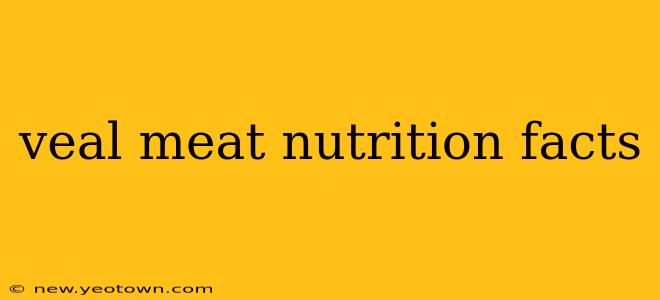Veal, the meat from young calves, often evokes strong opinions. Some view it as a delicacy, others as ethically questionable. But beyond the ethical considerations, veal offers a unique nutritional profile worth exploring. Let's delve into the world of veal meat nutrition facts, separating fact from fiction and uncovering the nutritional benefits this tender meat provides.
My journey into researching veal nutrition started with a simple question: Is veal really as healthy as other meats? This led me down a rabbit hole of scientific studies, nutritional databases, and expert opinions. What I discovered surprised me – and I hope it will surprise you too.
What are the nutritional benefits of veal?
Veal is a lean protein source, relatively low in fat, and packed with essential nutrients. A 3-ounce serving of veal generally provides:
-
High-Quality Protein: Veal is an excellent source of complete protein, meaning it contains all nine essential amino acids our bodies need but can't produce on their own. This protein is crucial for building and repairing tissues, making it essential for growth and overall health.
-
Essential Vitamins and Minerals: Veal is a good source of several B vitamins, including niacin and vitamin B12, vital for energy production and nerve function. It also contains minerals like iron, zinc, and selenium, which play important roles in immune function, cell growth, and antioxidant defense.
-
Low in Fat: Compared to some other red meats, veal is relatively lean, offering a lower fat content. This makes it a potentially healthier choice for those watching their fat intake. However, the fat content can vary depending on the cut and preparation method.
-
Rich in Niacin: Veal is particularly high in niacin, also known as vitamin B3. This vitamin plays a critical role in numerous bodily functions, including energy metabolism, DNA repair, and cell signaling. A deficiency in niacin can lead to various health problems.
Is veal healthier than beef?
This is a common question, and the answer isn't a simple "yes" or "no." Both veal and beef are sources of protein and essential nutrients. However, veal generally has a lower fat content and a slightly different micronutrient profile. The difference in health benefits often depends on the specific cut and preparation method for both meats. Lean cuts of both veal and beef can be part of a healthy diet.
How much fat is in veal?
The fat content in veal varies greatly depending on the cut and the age of the calf. Leaner cuts, such as veal loin or tenderloin, have significantly lower fat than richer cuts like veal shanks. The feeding practices of the calf can also affect the fat content. Always check the nutritional label for the specific fat content of the veal you are purchasing.
What are the health risks of eating veal?
While generally safe for consumption, some health risks are associated with veal consumption, similar to other red meats. These include:
-
Saturated Fat: Although leaner than some red meats, veal still contains some saturated fat, which can contribute to high cholesterol levels if consumed in excess.
-
Cholesterol: Veal, like other red meats, contains cholesterol. Individuals with high cholesterol should moderate their veal intake.
-
Sodium: Processed veal products often have high sodium content. Be mindful of your sodium intake when choosing processed veal items.
Is veal good for weight loss?
Veal can be part of a weight-loss diet due to its lean protein content, which helps promote satiety and can support muscle mass maintenance. However, the overall caloric intake and preparation method greatly influence its effectiveness for weight loss. Choosing lean cuts and avoiding high-fat cooking methods is crucial.
By understanding the nutritional facts of veal, you can make informed choices about incorporating this meat into your diet. Remember, moderation and balanced eating are key to a healthy lifestyle. Enjoy the deliciousness of veal responsibly!

